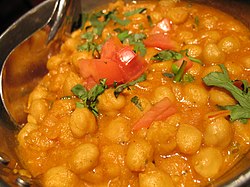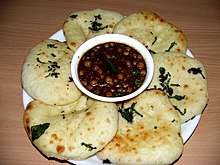 | |
| Place of origin | Indian subcontinent |
|---|---|
| Region or state | North India[1] |
| Main ingredients | Chickpeas, onion, tomatoes, coriander, garlic, chiles, ginger, oil, spices |
Chana masala (also chole masala, or chole) is a chickpea curry originating in the Indian subcontinent.[1][2][3][4] It is a staple dish in North Indian cuisine.[1] It is often eaten with a deep fried bread called bhatura.[5]
Ingredients[edit]

Along with chickpeas, the ingredients of chana masala typically include onion, chopped tomatoes, ghee, cumin, turmeric, coriander powder, garlic, chillies, ginger, amchoor or lemon juice, and garam masala.[6]
Preparation[edit]
To prepare chana masala, raw chickpeas are soaked overnight in water. They are then drained, rinsed, and cooked with onions, tomatoes, and spices.[2]

References[edit]
- ^ a b c Anupy, Anupy Singla (2010). The Indian Slow Cooker: 50 Healthy, Easy, Authentic Recipes. Agate Publishing. p. 77.
- ^ a b Singh, Manali (2018). Vegetarian Indian Cooking with Your Instant Pot: 75 Traditional Recipes That Are Easier, Quicker and Healthier. Page Street Publishing. pp. 13–14.
- ^ Vora, Nisha (2019). The Vegan Instant Pot Cookbook: Wholesome, Indulgent Plant-Based Recipes. Penguin Publishing Group. p. 342.
- ^ Richa Hingle (2022). Vegan Richa's Instant PotTM Cookbook: 150 Plant-based Recipes from Indian Cuisine and Beyond. Hachette Books. p. 166.
- ^ Kitchen, Hebbars (2020-12-23). "chole bhature recipe | chhole bhature | chana bhatura | chola batura". Hebbar's Kitchen. Retrieved 2024-06-04.
- ^ Pitre, Urvashi (September 19, 2017). Indian Instant Pot® Cookbook: Traditional Indian Dishes Made Easy and Fast. Rockridge Press. p. 54. ISBN 978-1939754547.




Well, that’s interesting to know that Psilotum nudum are known as whisk ferns. Psilotum nudum is the commoner species of the two. While the P. flaccidum is a rare species and is found in the tropical islands. Both the species are usually epiphytic in habit and grow upon tree ferns. These species may also be terrestrial and grow in humus or in the crevices of the rocks.
View the detailed Guide of Psilotum nudum: Detailed Study Of Psilotum Nudum (Whisk Fern), Classification, Anatomy, Reproduction